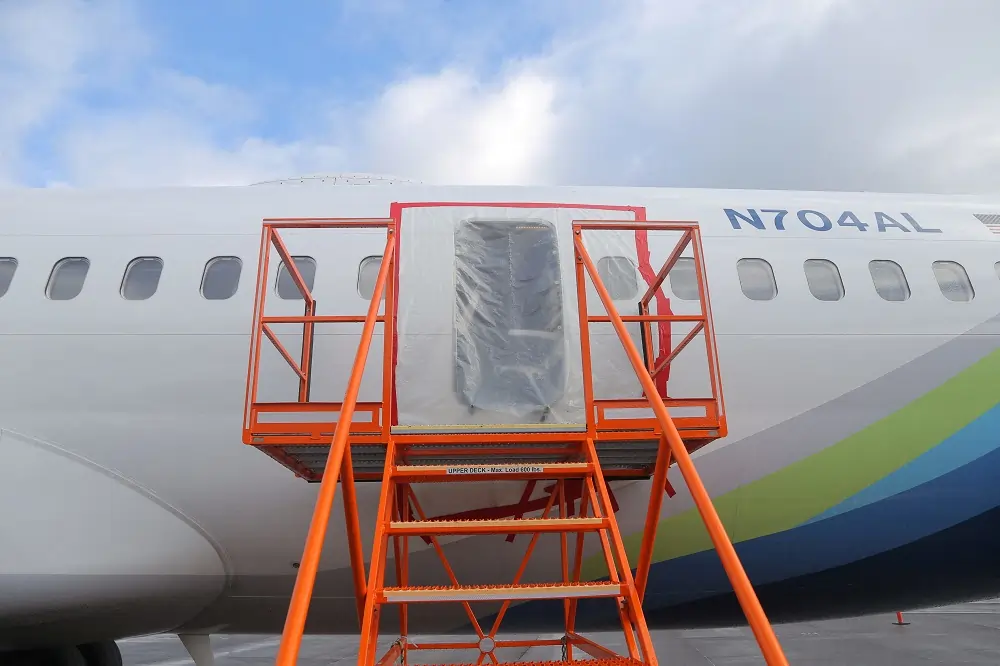
WASHINGTON (Reuters) -The U.S. Federal Aviation Administration said on Friday it will intensify oversight of Boeing after a panel broke off a new jet in mid-flight, and the agency’s chief Mike Whitaker sees “other manufacturing problems” at the largest U.S. planemaker.
The FAA said in a statement it will conduct a new audit of the Boeing 737 MAX 9 production line and its suppliers and may conduct further audits depending on the results.
The agency is also considering shifting additional FAA responsibilities assigned to Boeing to an independent entity after an Alaska Airlines jet had to make a dramatic emergency landing a week ago when the panel broke off, leaving a gaping hole in the fuselage.
Whitaker told CNBC the new MAX 9 airplane that had the mid-air emergency had “significant problems” and noted Boeing’s past history of production issues.
“We know there are problems with manufacturing, there have been problems in the past. But these are continuing and the aircraft was three months old,” Whitaker said of the Alaska airplane. “We believe there are other manufacturing problems as well.”
Alaska Airlines and United Airlines have canceled hundreds of flights since Saturday. The FAA on Saturday grounded 171 airplanes MAX 9 with the same configuration, while the National Transportation Safety Board (NTSB) is investigating if the MAX 9 was missing or had improperly tightened bolts.
Boeing shares fell 1.5% in morning trading and are down nearly 12% since the incident. Confidence in Boeing has been shaken since a pair of MAX 9 crashes in 2018 and 2019 killed 346 people.
Boeing did not immediately comment on the FAA’s latest move. On Thursday, the company said it would “cooperate fully and transparently with the FAA and the NTSB on their investigations.”
On Wednesday, CEO Dave Calhoun acknowledged on CNBC that there was a “quality” issue in allowing the MAX 9 to fly with the problem that caused the blowout.
On Thursday, the agency announced a formal investigation into the MAX 9. On Friday it said it would also reexamine its decision to delegate some responsibilities to Boeing and consider moving some functions under independent, third-party entities.
“The grounding of the 737 MAX 9 and the multiple production- related issues identified in recent years require us to look at every option to reduce risk,” Whitaker said.
In 2021, Boeing agreed to pay $6.6 million in penalties after failing to comply with a 2015 safety agreement. The FAA also launched an outside review of Boeing’s safety culture in January 2023.
Whitaker declined to put any timetable on whether the FAA might approve the inspection and maintenance instructions that would allow airlines to begin returning MAX 9 planes to service.
Talks between Boeing, the FAA and airlines ended for the day on Thursday without agreement on the instructions from Boeing that the regulator must approve before airlines can resume flying the planes.
The Alaska Airlines aircraft, which had been in service for just eight weeks, took off from Portland, Oregon last Friday and was flying at 16,000 feet (4,900 m) when the panel tore off the plane. Pilots returned the jet to Portland, with only minor injuries suffered by passengers.
Alaska and United, the other major U.S. carrier that operates 737 MAX 9 planes with that configuration, said they have found loose parts on multiple grounded aircraft during preliminary checks.
Delta Air Lines CEO Ed Bastian said he was confident Boeing would learn from the incident. “Boeing will continue to provide Delta as well as our industry with a great product going forward,” he said. Delta does not have MAX 9 in its fleet.
U.S. Senate Commerce Committee chair Maria Cantwell, who had urged the FAA in January 2023 to conduct a new Boeing audit, said Thursday recent accidents and incidents “call into question Boeing’s quality control.”
In March, the FAA said it was ramping up oversight of Boeing and had 107 full-time staff members providing regulatory oversight on Boeing, up from 82 in prior years. Since 2019 the agency has delegated fewer responsibilities to the planemaker.
The FAA continues to inspect each 737 MAX and 787 aircraft before an airworthiness certificate is issued and planes cleared for delivery. Typically the FAA delegates that responsibility to the manufacturer.
(Reporting by David Shepardson; additional reporting by Rajesh Kumar Singh in Chicago; Editing by Toby Chopra, Chizu Nomiyama and David Gregorio)


